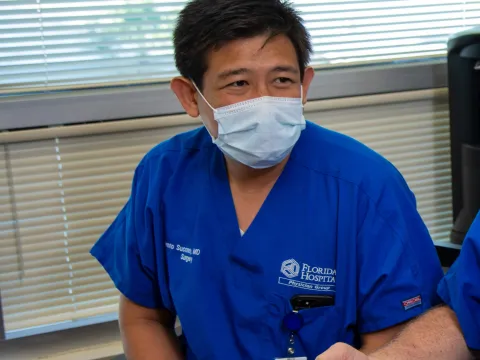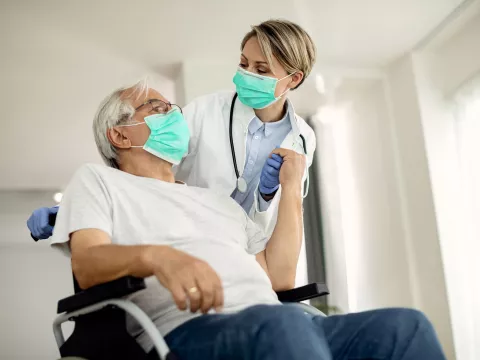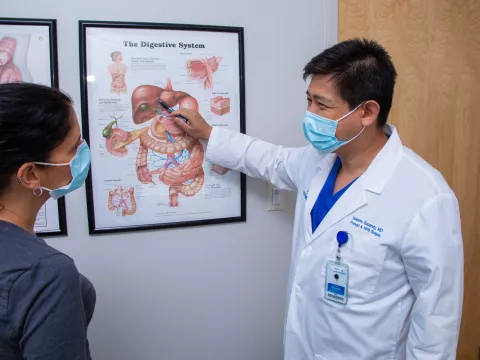- AdventHealth Digestive Health Institute
Choose the health content that’s right for you, and get it delivered right in your inbox.
On March 18, Iswanto Sucandy, MD, FACS, advanced HPB (liver, pancreas and bile duct) surgeon at AdventHealth Digestive Health Institute (DHI), gave two presentations at the Society of Surgical Oncology’s (SSO) International Conference on Surgical Conference Care. Because of the ongoing COVID-19 pandemic, the SSO 2021 meeting was virtual. This format likely allowed more surgeons to participate in the annual professional conference than usual. According to the SSO, the conference sessions “had phenomenal attendance.”
At the event, Dr. Sucandy presented two videos of actual operations in the “Top Rated Videos” session. These videos featured robotic surgery for liver and bile duct tumors that he, Sharona Ross, MD, FACS, and Alexander Rosemurgy, MD, FACS, advanced HPB and foregut surgeons at DI, offer their patients.
Minimally Invasive Surgery for the Caudate Lobe of the Liver
The first of the videos was entitled “Robotic Left Hepatectomy and Partial Caudate Resection for a Large Centrally Located Mass.” It was about a robotic liver surgery operation for a large tumor in the middlemost segment of the liver.
The liver is divided up into eight sections, and each functions alone apart from the other segments. The center segment is the caudate lobe. It is where many people’s right and left hepatic veins drain into the vena cava, the body’s largest vein. It’s also the place where the liver has many arteries. This complex structure of blood vessels makes operating on this part of the liver very challenging for surgeons. They have to be very careful in operating in this area or the patient could lose a lot of blood and face life-threatening complications.
Although some surgeons perform minimally invasive laparoscopic liver surgery, most operations on the caudate lobe are done as open procedures. Many surgeons prefer an open approach because they believe it helps them avoid accidentally hitting critical blood vessels. However open liver surgery is very involved. Patients have long recoveries and often spend five to 10 days in the hospital.
At DI, Dr. Sucandy, Dr. Ross and Dr. Rosemurgy, strive to offer as many of their operations as possible as minimally invasive procedures. Therefore, when operating on the caudate lobe, they turn to the da Vinci Surgical System when they can. The surgical robot helps them perform the delicate surgery needed to remove tumors in central part of the liver. It allows patients to have the closed operation that will give them a far easier recovery.
Almost Like an Open Operation
In this case, the patient had a tumor about the size of a lime situated between two primary veins in the liver. Dr. Sucandy, Dr. Ross and Dr. Rosemurgy were able to remove the tumor and some of the surrounding liver tissue while still preserving these veins. That’s important because the liver needs a way for blood to flow out of it and back to the heart. Live imaging in the form of ultrasound and the 3-D camera on the da Vinci Surgical System also allowed the surgeons to delicately operate around the main arteries in this part of the liver.
“The robotic system really facilities precise and safe dissection of the left hepatic artery without being confused … with the surrounding structures,” said Dr. Sucandy during his presentation. “This is almost like doing an open operation,” he continued.
During the three-hour operating time, the patient only lost about 100 mL of blood, less than half a cup. The patient, younger than the typical person who needs liver surgery, was discharged from the hospital just three days after surgery. The DI surgeons concluded that robotic surgery is a safe alternative to open surgery for complex liver operations.
Pioneering Robotic Surgery for Bile Duct Cancer
Dr. Sucandy’s second video was “Robotic Extrahepatic Biliary Resection with Roux-en-Y Hepaticojejunostomy for Type 2 Klatskin Tumor.” Klatskin tumor is a type of bile duct cancer. It is widely believed that using minimally invasive surgery to remove Klatskin tumor is too technically complex. Also, it might make it more difficult for the surgeon to remove the entire cancer tumor.
That said, Dr. Sucandy, Dr. Ross and Dr. Rosemurgy have pioneered robotic surgery in the United States for Klatskin tumor. While they have used this approach on a number of patients, Dr. Sucandy’s presentation centered on a specific case. Using the straightforward case as an example, he demonstrated to other complex gastrointestinal cancer surgeons the technique DI surgeons employ to remove the Klatskin tumor, part of the common bile duct and some of the area lymph nodes with the surgical robot.
While the patient was still in surgery, the removed common bile duct portion was checked for cancer. If cancer cells had been found at the edge of the bile duct, more tissues would have been removed to ensure all of the cancer was taken out. After the cancerous tissues were gone, the surgeons reconstructed the bile duct system. This allows bile to flow from the liver to the small intestine, where it is needed for digestion.
“The benefit of the robot is we can see each of the needle passing and direct facilitation,” said Dr. Sucandy. Indeed, the video taken with the surgical robot’s camera showed a high-resolution close-up of the surgical needle and suture (stitch) material as they rejoined the tissues.
The elderly patient handled the procedure well and was discharged from the hospital four days after surgery. The DI HPB surgeons concluded that they are able to offer robotic surgery for Klatskin tumor, in many cases, just as easily as an open procedure. Therefore, this approach should be considered a good alternative to a more invasive, open operation.
While robotic surgery is still very rare for liver and bile duct cancers, it is something that the DI surgeons do quite well. When patients have less invasive operations such as these, they recover more quickly. Importantly, this means they can start their next cancer therapy all the sooner.
If you or a loved one needs surgery for a digestive cancer, learn more about your minimally invasive options. For a consultation with an advanced HPB surgeon, call us at Call844-650-5950.





